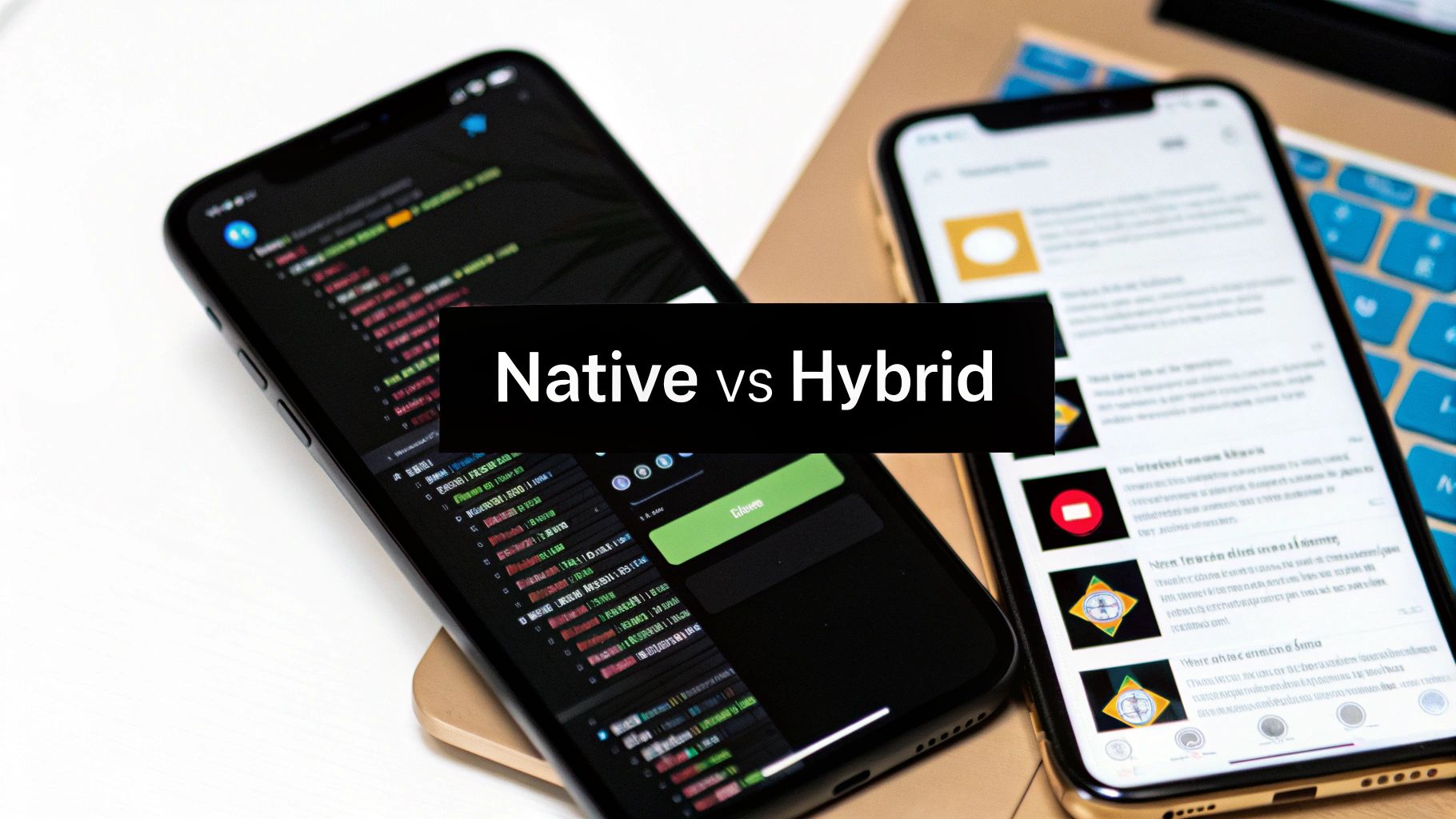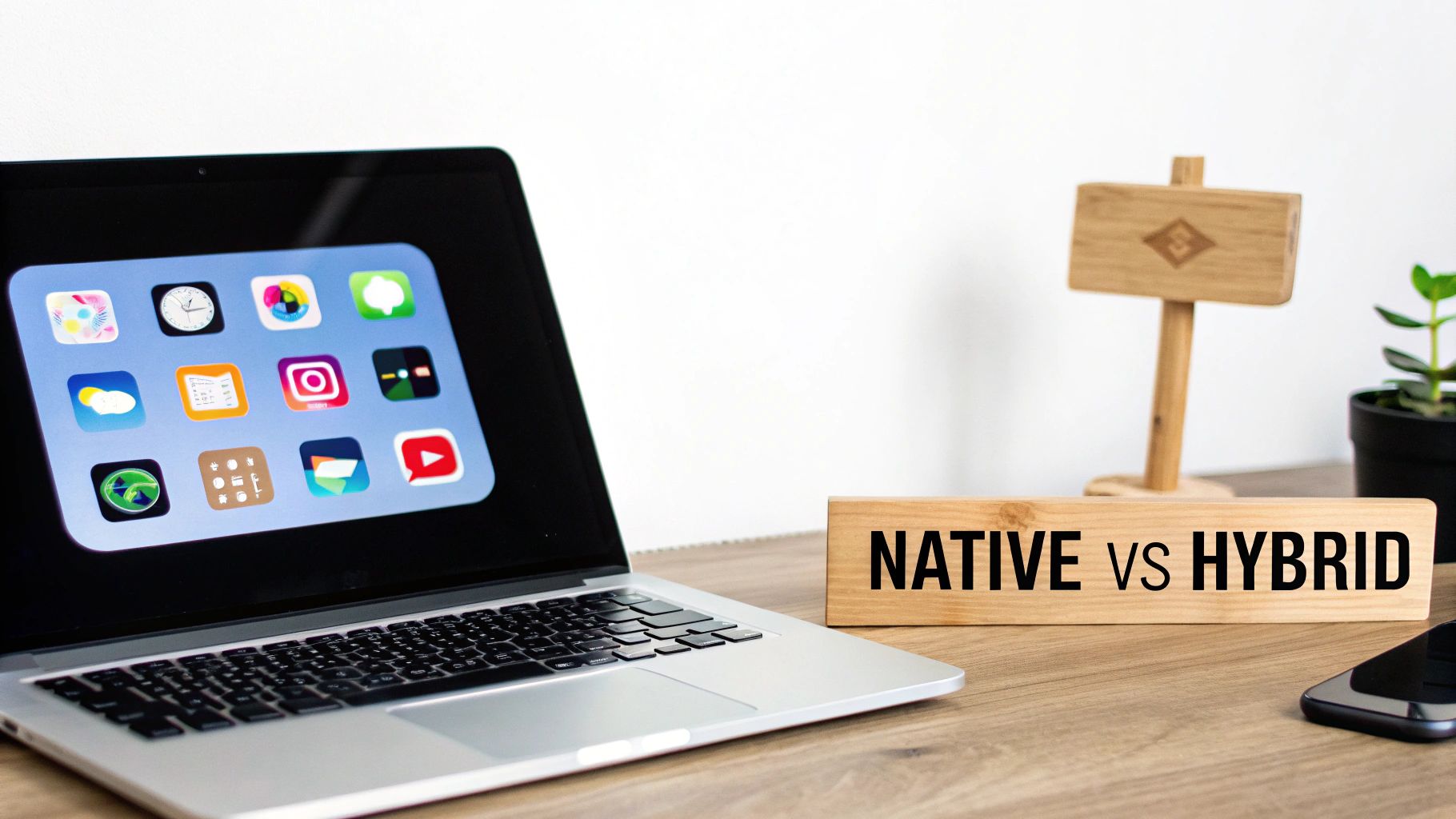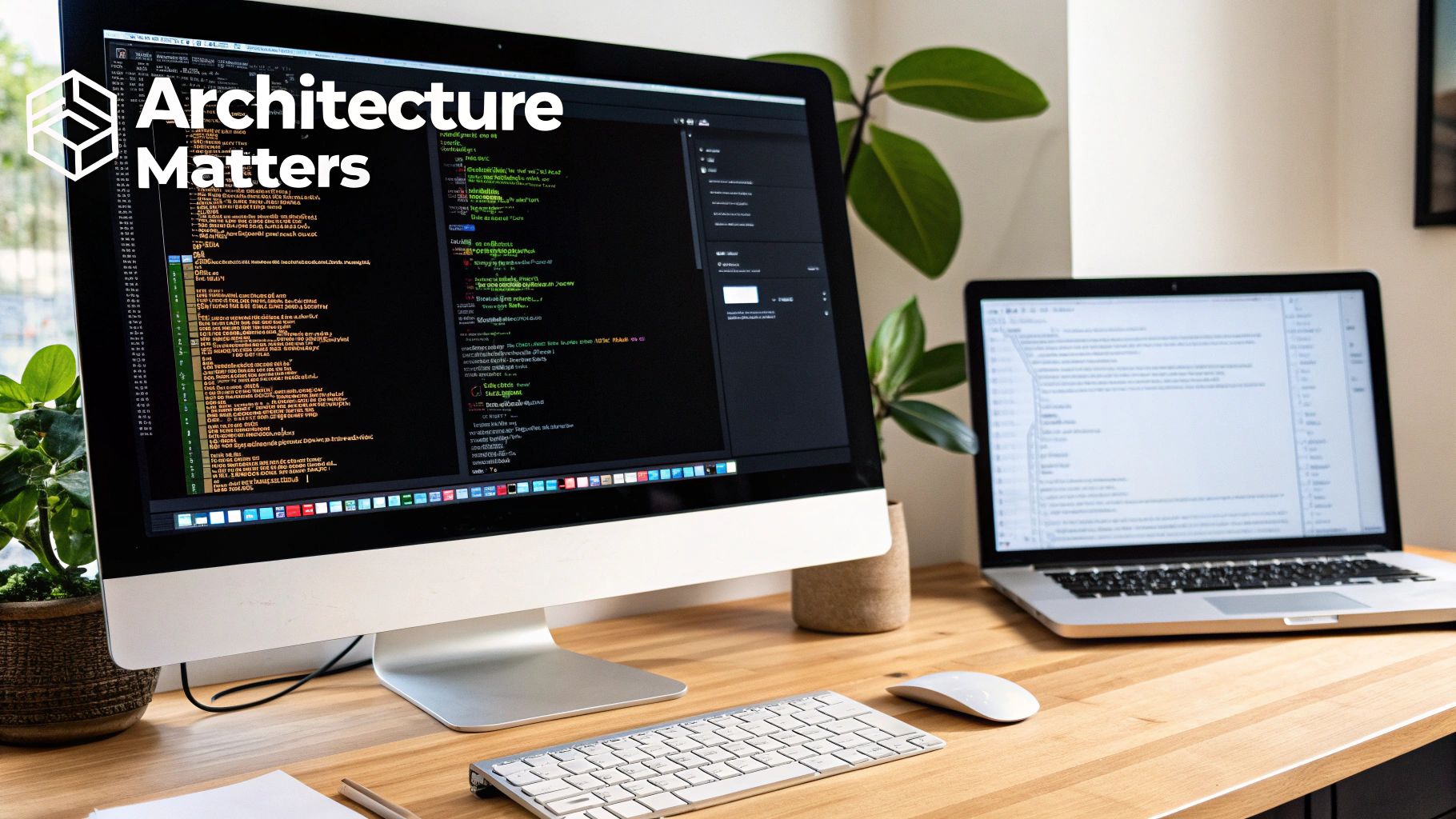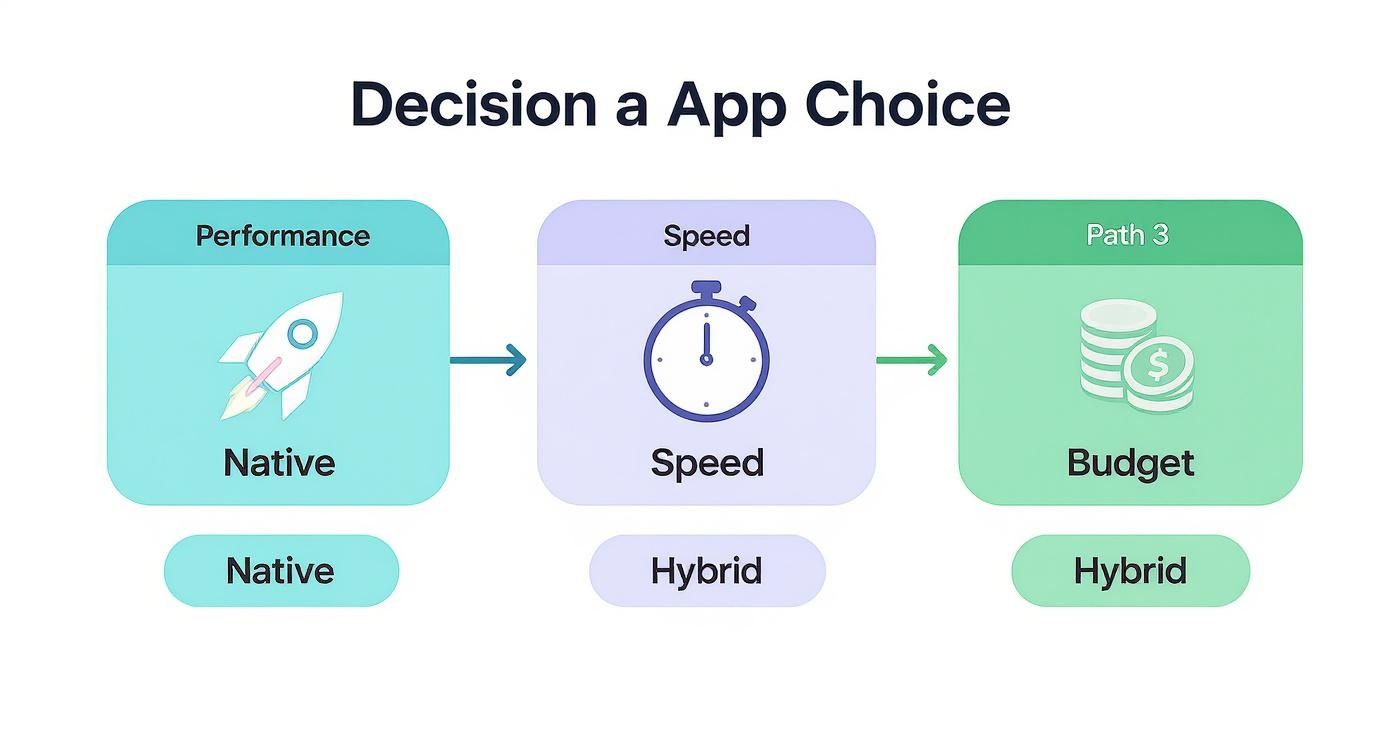Native vs. Hybrid App Development: A Founder's Guide
Deciding on native vs hybrid app development? This guide provides a balanced comparison of performance, cost, and UX with real-world use cases.
By Parth
27th Oct 2025

The entire native vs. hybrid app development debate boils down to one critical trade-off. Do you build an app specifically for iOS and another for Android to deliver the absolute best performance, or do you build it once to run on both, getting to market faster and for less money?
For a founder, product manager, or anyone launching a new mobile product, your decision hinges on what you value more: a flawless user experience that justifies a higher budget, or a faster, more cost-effective launch.
Choosing Your Development Path: Native vs. Hybrid

Staring at this crossroads can feel overwhelming. This isn't just a technical decision—it’s a business choice that impacts your entire budget, timeline, user experience, and long-term product roadmap. This guide cuts through the jargon to frame the debate around what actually matters for your business.
We’re going to focus on the practical outcomes of each approach. Forget abstract definitions. What really matters is how these technical choices impact your product's performance, forcing you to balance development speed, UI polish, cost, and future-proofing.
Core Concepts at a Glance
Before we get into the nitty-gritty, let's nail down the core ideas. Native development means using the language a platform was built for—like Swift for iOS and Kotlin for Android. This allows the app to speak the device's "native tongue," giving you unmatched performance and direct access to all its features. For example, a high-frequency trading app built natively on iOS can leverage the full power of the iPhone's processor for instant trade execution.
Hybrid development, on the other hand, typically uses web technologies like JavaScript inside a framework such as React Native. You write the code once, and it gets packaged to run on both iOS and Android. It’s a powerful shortcut that lets a small team launch an e-commerce app on both platforms simultaneously.
The bottom line is this: There is no single 'best' choice, only the 'right' choice for your specific product, team, and market. Your decision has to line up with both your immediate needs and your long-term vision.
A High-Level Comparison
To give everyone on the team—especially non-technical stakeholders—some quick context, here’s a snapshot of the key differences we'll explore in detail.
| Criteria | Native App Development | Hybrid App Development |
|---|---|---|
| Performance | The absolute best you can get; direct access to all OS features. | Good, but always a step behind native; needs a "bridge" to talk to the OS. |
| User Experience | Flawless; perfectly follows the specific UI/UX rules of each platform. | Can feel very close to native but might occasionally seem slightly "off" or less integrated. |
| Cost & Speed | More expensive and takes longer; you're building and managing two separate apps. | Cheaper and much faster to market; you're working with a single, shared codebase. |
| Maintenance | More complex; you have to update two different apps for every change. | Much simpler; update the one codebase, and the changes apply to both platforms. |
How App Architecture Shapes Your Product

Choosing between native and hybrid development is about more than just the code—it’s about setting the foundation of your product. Think of your app's architecture as its nervous system. It dictates how your app thinks, reacts, and talks to the device it’s running on. This single decision has a ripple effect on everything from performance to the user experience.
A native app is like a local. It speaks the language fluently and knows every shortcut. Built with platform-specific languages like Swift for iOS and Kotlin for Android, it communicates directly with the device's operating system (OS). There are no translators or middlemen.
This direct line is the secret to native’s famous performance. When a user taps a button, the request goes straight to the OS, which means the action feels instantaneous. It’s why you’ll find native architecture powering graphics-heavy games like Genshin Impact or AR apps that project virtual furniture into your living room.
The Native Advantage: Direct Communication
The benefits of this direct connection are tangible. Native apps can tap into every piece of hardware and every new software feature the moment Apple or Google releases it.
- Maximum Performance: With no abstraction layers to slow things down, you get the fastest possible animations and the smoothest data processing.
- Full Hardware Access: Your app can reliably use advanced device features—think LiDAR scanners, complex camera APIs, and biometric sensors—without compromise.
- Platform-Perfect UX: The interface naturally follows the official design guidelines for iOS and Android, so the app feels familiar and intuitive. For more on this, see our guide on choosing a user interface design framework.
This approach delivers a premium experience, but it’s not without its costs. You’re building and maintaining two completely separate applications.
The Hybrid Approach: A Skilled Interpreter
Hybrid development offers a more efficient path. Picture hiring one expert interpreter who can speak flawlessly to two different audiences. The interpreter is a hybrid framework like React Native or Flutter. You write the logic once, and the framework translates it for both iOS and Android.
This translation happens across a "bridge," a piece of software that converts your single codebase (written in JavaScript or Dart) into the native UI components and commands that each OS understands. This is what makes the "write once, run anywhere" promise a reality.
Key Takeaway: The architectural difference is simple. Native apps speak the device’s language directly. Hybrid apps use a translation layer or 'bridge' to communicate, introducing a small but often negligible delay in exchange for massive development efficiency.
The biggest win here is speed to market. Instead of running two separate teams, you build, update, and maintain a single codebase. For many startups launching an MVP, this is a game-changer. It allows them to validate an idea on two platforms without doubling their engineering budget.
While the bridge adds a slight performance overhead compared to a purely native app, modern frameworks are incredibly efficient. For the vast majority of apps—e-commerce stores, social media platforms, internal business tools—the trade-off is absolutely worth it, making hybrid a powerful and pragmatic choice.
Comparing the Key Decision Factors

Alright, we’ve covered the architecture. Now, let's get practical and put these two approaches head-to-head. This isn’t just a list of pros and cons; it’s about understanding the real-world trade-offs that will make or break your product.
Choosing between native and hybrid development comes down to how you weigh these specific factors against your business goals, budget, and timeline. We'll connect the technical jargon to what it actually means for your bottom line and your users' happiness.
Performance and Responsiveness
Let's be blunt: performance isn't just about speed. It's about how an app feels. Does it respond instantly, or is there a slight, frustrating delay? Native apps are the undisputed kings here. They speak the device's language directly, with no middleman, so there's zero translation lag.
This raw power is a must-have for certain applications. Think about an IoT app controlling your smart home lights. You tap the button, and the light needs to turn on now. Any hesitation makes the whole system feel cheap. The same goes for high-end mobile games or augmented reality apps that need to squeeze every last drop of power from the GPU. Only native code can deliver that level of smooth interaction.
Hybrid apps, on the other hand, use a "bridge" to talk to the operating system, which adds a tiny bit of overhead. While modern frameworks have made this bridge astonishingly fast, it's still there. For the vast majority of apps—think e-commerce stores, social media feeds, or news readers—this performance difference is so minimal that no human user would ever notice it.
Key Differentiator: Native hits the absolute performance ceiling, which is non-negotiable for graphically intense or real-time hardware control apps. Hybrid delivers fantastic performance that is more than enough for over 90% of typical business and consumer applications.
User Experience and UI Fidelity
A great user experience feels familiar. iOS users expect iOS-style navigation, and Android users expect Android's Material Design. Native development nails this effortlessly because you're building with the platform's own toolkit.
When you build an iOS app with Swift, it just feels like an iPhone app, from the screen transitions to the pop-up modals. Likewise, a Kotlin-built Android app will feel right at home on a Pixel or Samsung device. This "platform fidelity" makes your app intuitive and builds trust.
Hybrid frameworks do an incredible job of recreating these native components, but they are, at the end of the day, expert imitations. A top-tier development team can get you 99% of the way there, but tiny details can sometimes give it away. A button's haptic feedback might feel slightly off, or a page transition might not have the exact native physics. These are small things, but they can make an app feel just a little out of place.
Development Speed and Cost
Here’s where the conversation often starts and ends for startups and budget-conscious businesses. Hybrid development wins on speed and cost, hands down. The logic is simple: you write the code once, and it runs on both iOS and Android.
This single-codebase approach creates a domino effect of efficiency:
- Faster Time-to-Market: You can get your MVP into both the App Store and Google Play in a fraction of the time.
- Lower Costs: You’re hiring and paying for one development team, not two separate, specialized ones. We dig deeper into this in our guide on mobile app development costs.
- Easier Project Management: One roadmap, one team, one set of priorities. It's infinitely simpler to manage than two parallel projects.
Going native means you’re essentially building two separate products. You need Swift/iOS experts and Kotlin/Android experts, which doubles your payroll and stretches your timeline. This is a worthwhile investment, but only when the app’s entire value proposition hinges on that last ounce of performance or a deep hardware integration.
Long-Term Maintenance and Updates
Your app launch is just the starting line. The real marathon is the ongoing cycle of bug fixes, security patches, and feature updates. This is another area where a hybrid app's single codebase pays huge dividends.
Find a bug? Fix it once. Want to add a new feature? Build it once. The update then rolls out seamlessly to all your users on both platforms. This unified process makes version control a breeze and ensures a consistent experience for everyone.
With two native apps, every single change has to be implemented, tested, and deployed twice. This doubles the workload and the chances of introducing new, platform-specific bugs. When planning your project, it is crucial to account for all mobile app testing considerations, as the effort required can differ dramatically. For smaller teams, this dual maintenance burden can quickly become overwhelming.
Modern hybrid frameworks have all but erased the old performance gaps. For startups and SMEs, the ability to reuse 70-90% of their code to target iOS, Android, and even the web is a massive advantage. It slashes development costs and drastically simplifies long-term maintenance, making hybrid a powerful, strategic choice.
Native vs Hybrid: A Factor-Based Showdown
To make this crystal clear, let's break it down in a table. This isn't about which one is "better" in a vacuum, but which is better for your specific situation.
| Decision Factor | Native Development (iOS/Android) | Hybrid Development (React Native/Flutter) | Best For... |
|---|---|---|---|
| Performance | Unmatched. Direct access to device hardware. | Excellent for most apps, but with a slight overhead. | Native: High-end games, AR/VR, real-time IoT. |
| User Experience (UX) | Perfect platform fidelity. Feels 100% "at home." | Near-native feel, but minor inconsistencies can occur. | Hybrid: Most B2B/B2C apps (e-commerce, social). |
| Dev Speed & Cost | Slower and more expensive (two separate codebases). | Faster and more cost-effective (one shared codebase). | Hybrid: MVPs, startups, budget-conscious projects. |
| Maintenance | Complex. Requires parallel updates for both platforms. | Streamlined. Fix or update once for both platforms. | Hybrid: Teams looking for long-term efficiency. |
| Native API Access | Immediate and direct access to all new device features. | Access via native modules or plugins; may have a slight delay. | Native: Apps relying on bleeding-edge OS features. |
| Team Skills | Requires two specialized teams (Swift/iOS, Kotlin/Android). | Requires one team skilled in JavaScript/Dart. | Hybrid: Companies with existing web development talent. |
Ultimately, the right choice depends on a clear-eyed assessment of your priorities. Are you building a graphically intense game where every millisecond counts? Go native. Are you building a content-driven app for a startup that needs to get to market quickly on both platforms? Hybrid is almost certainly your best bet.
Real-World Scenarios: Making the Call
Theory is one thing, but the real test comes when you have to make a decision for your own project. The "native vs. hybrid" debate becomes much clearer once you connect it to a real product, real users, and real business goals. Let's look at concrete examples where one path is clearly the better choice.
This isn't about which technology is "superior." It's about picking the right tool for the job. By looking at well-known apps and common product types, you can see how these technical decisions lead directly to business success.
When Native Development Is Non-Negotiable
You go native when performance, security, and a flawless user experience are the entire point of your app. In these cases, there's no room for compromise. The higher upfront investment is justified because the app needs to feel incredibly responsive, powerful, and perfectly integrated with the device.
Here are a few situations where going native is the only logical choice:
- High-Performance Mobile Games: Think about graphically intense games like Genshin Impact or Call of Duty Mobile. They need raw, direct access to the device's GPU and CPU to render complex 3D worlds and react instantly to player input. A hybrid framework's "bridge" would create a performance bottleneck, making the game feel sluggish and unplayable.
- Augmented Reality (AR) and Virtual Reality (VR) Apps: Apps like IKEA Place, which lets you see furniture in your home, depend on deep, real-time access to the device's camera, gyroscope, and specialized hardware like the LiDAR sensor. Native code is the only way to get the direct hardware communication needed for stable, believable AR overlays.
- Secure Fintech and Banking Platforms: When you're handling people's money, there is zero tolerance for lag or security gaps. Banking apps from giants like Chase or trading platforms like Robinhood are built natively to ensure every transaction is fast, reliable, and locked down by the operating system’s toughest security features.
Key Insight: For these apps, the user experience is the product. Any glitch or delay directly undermines the app's entire value proposition. The investment in native development isn't a luxury; it's essential.
In these fields, complex interactions and ultra-responsive interfaces are the standard. Industries like fintech, healthcare, and logistics build on native foundations because performance is directly tied to revenue and user trust. For a deeper dive, you can discover more insights on why specific sectors choose native development.
When Hybrid Development Is the Smart Strategic Move
Hybrid development, especially with modern frameworks like React Native, is the champion of speed and efficiency. It’s the pragmatic, strategic choice for a massive range of apps where the main goal is to reach the widest audience quickly without the cost of building two separate products from scratch.
Consider these common scenarios where a hybrid approach just makes sense:
- E-commerce and Retail Apps: Most retail apps, like those for Zara or Etsy, are primarily about displaying content. Users browse product catalogs, manage a shopping cart, and check out—all things that don't need intense graphical power. A hybrid build lets a retailer offer a consistent brand experience on both iOS and Android while managing a single codebase.
- Social Media and Content-Driven Apps: Instagram famously uses React Native to ship new features faster across both platforms. For apps built around scrolling feeds and viewing content, a hybrid framework delivers more than enough performance while letting the engineering team move much quicker.
- Internal Enterprise Tools: Companies often build apps for their employees to manage inventory or access internal dashboards. For these use cases, getting a functional tool into employees' hands quickly is far more important than a pixel-perfect native aesthetic. Hybrid development makes it fast and affordable to roll out a useful app to the entire workforce.
- Minimum Viable Products (MVPs): For any startup, validating an idea is priority number one. A hybrid approach is often the perfect way to build an MVP. It allows founders to get their core concept onto both the App Store and Google Play with a fraction of the time and money. Our guide on using an MVP builder for mobile apps shows how this strategy can seriously speed up your journey to finding product-market fit.
A Practical Framework for Making Your Choice
The native vs. hybrid debate can feel like an endless loop. To get out of it, you have to stop comparing technologies and start asking sharp, strategic questions about your business. This isn't about picking the "best" tech; it's about matching your development choice to your immediate goals and long-term vision.
Working through the following questions with your team will bring the right path into focus. It’s how you turn a messy technical decision into a clear business strategy.
What Is Your Primary Business Goal Right Now?
Before a single line of code gets written, you need to define what success looks like over the next six months. Are you just trying to see if an idea has legs with a Minimum Viable Product (MVP)? Or are you scaling a proven product where user retention is the name of the game?
- For Market Validation: If your immediate goal is to test a hypothesis and get real user feedback as fast and cheap as possible, a hybrid approach is almost always the right call. Getting to market on both iOS and Android simultaneously is a massive advantage here.
- For User Retention and Growth: If you're working with an established product, your goal is to delight users with a flawless, high-performance experience. In this case, the investment in native development is much easier to justify. A premium feel can be the one thing that sets you apart from the competition.
How Critical Is Elite Performance to Your Core User Experience?
Let’s be honest: how much raw power does your app really need? Every founder wants a "fast" app, but not every app’s core function depends on millisecond responsiveness.
Think of it as a spectrum. An e-commerce app that takes an extra 100 milliseconds to load a product image is perfectly fine. A mobile game that stutters or drops frames is fundamentally broken.
The decision often boils down to this: Is exceptional performance a nice-to-have, or is it the entire product? If it's the latter, native is your only serious option.
What Are Your Real-World Budget and Timeline Constraints?
This is where idealism hits a brick wall. Your budget and timeline are your most important strategic guides. Going native means building two separate apps, which means finding and hiring specialized iOS and Android developers. That doubles your hiring headaches and your payroll.
Hybrid development, especially with a framework like React Native, lets a single team—often staffed with web developers you already have—build for both platforms. This dramatically slashes upfront costs and gets you to launch day much faster. For a startup, that can be the difference between getting funded and running out of cash.
How Do You Plan for Long-Term Maintenance and Scaling?
Getting your app launched is just the starting line. The real work is in the months and years of updates, bug fixes, and new features that come next.
- Native Maintenance: Every single update has to be developed, tested, and deployed twice. This doubles the maintenance workload and makes it much harder to keep both apps perfectly in sync.
- Hybrid Maintenance: With a single codebase, you fix a bug once or add a feature once, and the changes roll out everywhere. For a small team, this streamlined process is a huge operational win.
Think about a pragmatic, phased approach. You could launch your MVP with a hybrid framework to validate your idea quickly and affordably. If you later discover that one specific, performance-hungry feature—like a complex photo editor—is struggling, you can rebuild just that one piece with native code. This strategy turns a scary, one-time decision into a flexible product plan that evolves with your business.
Frequently Asked Questions
After walking through all the technical details, you're probably still wrestling with a few specific "what-if" scenarios. That's perfectly normal. This is where the rubber meets the road, and you need clear, straightforward answers to the questions that pop up right before you commit.
We've gathered the most common questions we hear from founders and product teams to help you nail down your decision.
Think of this decision tree as a gut check. It boils down your choice to the single most important factor: pure performance, getting to market fast, or staying on budget.

As you can see, if you're chasing elite performance, native is the only way to go. But if your main drivers are speed and cost-efficiency, the path almost always leads to a hybrid approach.
What Is the Real Performance Difference Users Notice?
Honestly, for most apps, users won't notice a thing. The performance gap between native and hybrid has closed significantly. For things like e-commerce, social media, or content-driven apps, modern hybrid frameworks feel just as snappy and fluid as their native counterparts.
The difference becomes glaringly obvious when you push the hardware. Think graphically intense mobile games, augmented reality experiences, or apps that need instant responses from device sensors. In those cases, a user will feel the subtle lag or choppiness of a hybrid app. For over 90% of business and consumer apps, though, hybrid performance is more than enough.
Can a Hybrid App Access All Device Features?
For the most part, yes. Hybrid frameworks like React Native rely on a bridge and native modules—essentially plugins—to tap into device hardware like the camera, GPS, accelerometer, and Bluetooth. It works great for all the standard features you'd expect.
The catch comes with brand-new, cutting-edge hardware or OS features. When Apple or Google releases a new sensor or API, native developers can use it immediately. The hybrid community, on the other hand, has to play catch-up and build a reliable plugin, which can take time.
Key Takeaway: If your app's killer feature depends on having immediate access to the absolute latest OS-level APIs the day they are announced, you need to go native.
Why Do Big Companies Still Choose Native Development?
When you see a major enterprise build a native flagship app, it's usually about more than just silky-smooth animations. Their decision is often rooted in risk management and long-term control.
Here’s what they’re thinking:
- Maximum Security: For banking, healthcare, or any app handling sensitive data, native allows for deeper integration with platform-specific security features, leaving less room for error.
- Unlimited Scalability: When you're planning for tens of millions of users and a feature set that will evolve for a decade, a native foundation offers a more predictable and robust runway for growth.
- Talent and Control: Big companies can afford to hire and retain separate, specialized iOS and Android teams. This gives them absolute, granular control over every pixel and every line of code.
For these mission-critical applications where the budget is a distant second to performance and security, the heavy investment in native development is a calculated strategic move. For everyone else, hybrid delivers a far more practical balance.
Ready to build your mobile app UI without the steep learning curve? With RapidNative, you can turn your ideas into production-ready React Native code using simple text prompts. Stop wrestling with boilerplate and start shipping faster by exploring the AI mobile app builder at rapidnative.com.
Ready to Build Your mobile App with AI?
Turn your idea into a production-ready React Native app in minutes. Just describe what you want to build, andRapidNative generates the code for you.
Start Building with PromptsNo credit card required • Export clean code • Built on React Native & Expo